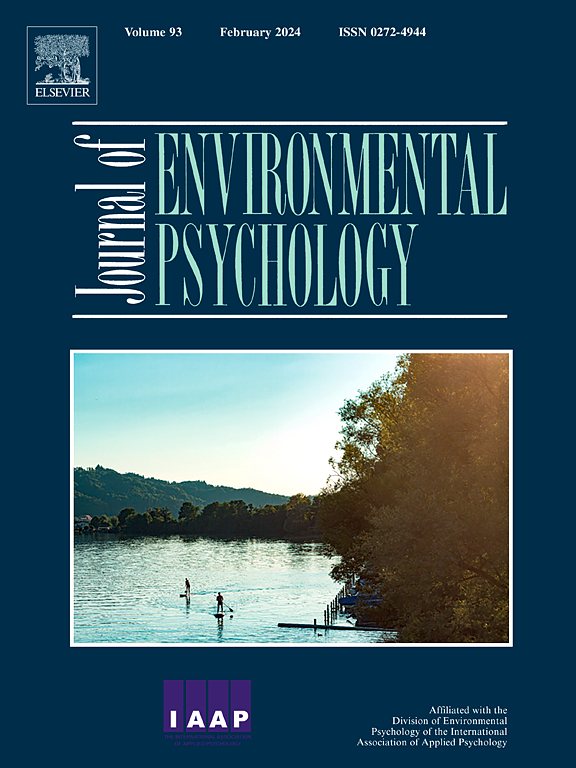Linking biodiversity perception with restorativeness: Mechanism and moderators
IF 7
1区 心理学
Q1 ENVIRONMENTAL STUDIES
引用次数: 0
Abstract
This study contributes to research on the restorative capacity of contact with nature by investigating a novel process mechanism, including important boundary conditions, and by linking restorativeness with behavioral intentions relevant to businesses. We develop and test a conditional process model where people's momentary feelings of being one with nature (state nature connectedness) mediate effects of perception of biodiversity on restorativeness, in turn, stimulating behavioral intentions (to visit the place, to purchase products from there and to engage in positive word-of-mouth). This novel mechanism was tested against two boundary conditions: an individual's frequency of exposure to nature and their need-for-deceleration. Results from three studies (N1 = 71; N2 = 258; N3 = 301) strongly support the mediating role of state connectedness with nature on restorativeness with positive downstream effects on behavioral intention. While we found no moderating effect of frequency of nature exposure on the relationship between perceived biodiversity and state nature connectedness, the relationship between connectedness and restorativeness gets weaker as levels of a need-for-deceleration increased. Including an alternative process explanation through aesthetics along with a number of control variables attests to the mechanism's robustness. Implications center on the power of perceptions of higher biodiversity to work through a heightened feeling of connectedness with nature, in turn improving restorativeness and stimulating behavioral intentions.
生物多样性感知与恢复性的联系:机制与调节因子
本研究通过探索一种新的过程机制,包括重要的边界条件,并将恢复性与商业相关的行为意图联系起来,为研究与自然接触的恢复性能力做出了贡献。我们开发并测试了一个条件过程模型,在这个模型中,人们与自然合一的瞬间感受(状态与自然的联系)介导了对生物多样性的感知对恢复性的影响,进而刺激了行为意图(参观这个地方,从那里购买产品,并参与积极的口碑传播)。这种新机制在两个边界条件下进行了测试:个体接触自然的频率和减速需求。三项研究结果(N1 = 71;n2 = 258;N3 = 301)强烈支持状态与自然联系对恢复性的中介作用,并对行为意向具有正向的下游效应。虽然我们发现自然暴露频率对感知生物多样性和状态自然连通性之间的关系没有调节作用,但连通性和恢复性之间的关系随着减速需求水平的增加而减弱。包括通过美学和一些控制变量的替代过程解释,证明了机制的鲁棒性。这一研究的意义在于,对更高生物多样性的认知,能够通过与自然的高度联系来发挥作用,进而提高恢复性,刺激行为意图。
本文章由计算机程序翻译,如有差异,请以英文原文为准。
求助全文
约1分钟内获得全文
求助全文
来源期刊

Journal of Environmental Psychology
Multiple-
CiteScore
10.60
自引率
8.70%
发文量
140
审稿时长
62 days
期刊介绍:
The Journal of Environmental Psychology is the premier journal in the field, serving individuals in a wide range of disciplines who have an interest in the scientific study of the transactions and interrelationships between people and their surroundings (including built, social, natural and virtual environments, the use and abuse of nature and natural resources, and sustainability-related behavior). The journal publishes internationally contributed empirical studies and reviews of research on these topics that advance new insights. As an important forum for the field, the journal publishes some of the most influential papers in the discipline that reflect the scientific development of environmental psychology. Contributions on theoretical, methodological, and practical aspects of all human-environment interactions are welcome, along with innovative or interdisciplinary approaches that have a psychological emphasis. Research areas include: •Psychological and behavioral aspects of people and nature •Cognitive mapping, spatial cognition and wayfinding •Ecological consequences of human actions •Theories of place, place attachment, and place identity •Environmental risks and hazards: perception, behavior, and management •Perception and evaluation of buildings and natural landscapes •Effects of physical and natural settings on human cognition and health •Theories of proenvironmental behavior, norms, attitudes, and personality •Psychology of sustainability and climate change •Psychological aspects of resource management and crises •Social use of space: crowding, privacy, territoriality, personal space •Design of, and experiences related to, the physical aspects of workplaces, schools, residences, public buildings and public space
 求助内容:
求助内容: 应助结果提醒方式:
应助结果提醒方式:


